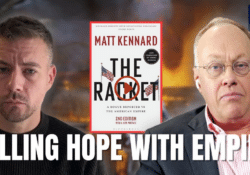

“It’s brave to admit your fears” – Ukrainian recruiting poster. Photo credit: Ministry of Defense, Ukraine
Who Wants to Kill and Die for the American Empire?
by Nicolas J. S. Davies | Sep 6, 2024
The Associated Press reports that many of the recruits drafted under Ukraine’s new conscription law lack the motivation and military indoctrination required to actually aim their weapons and fire at Russian soldiers.
“Some people don’t want to shoot. They see the enemy in the firing position in trenches but don’t open fire. … That is why our men are dying,” said a frustrated battalion commander in Ukraine’s 47th Brigade. “When they don’t use the weapon, they are ineffective.”
This is familiar territory to anyone who has studied the work of U.S. Brigadier General Samuel “Slam” Marshall, a First World War veteran and the chief combat historian of the U.S. Army in the Second World War. Marshall conducted hundreds of post-combat small group sessions with U.S. troops in the Pacific and Europe, and documented his findings in his book, Men Against Fire: the Problem of Battle Command.
One of Slam Marshall’s most startling and controversial findings was that only about 15% of U.S. troops in combat actually fired their weapons at the enemy. In no case did that ever rise above 25%, even when failing to fire placed the soldiers’ own lives in greater danger.
We must refuse to volunteer our bodies and those of our children and grandchildren as their cannon fodder, or allow them to shift that fate onto our neighbors, friends, and “allies” in other countries.
Marshall concluded that most human beings have a natural aversion to killing other human beings, often reinforced by our upbringing and religious beliefs, and that turning civilians into effective combat soldiers therefore requires training and indoctrination expressly designed to override our natural respect for fellow human life. This dichotomy between human nature and killing in war is now understood to lie at the root of much of the PTSD suffered by combat veterans.
Marshall’s conclusions were incorporated into U.S. military training, with the introduction of firing range targets that looked like enemy soldiers and deliberate indoctrination to dehumanize the enemy in soldiers’ minds. When he conducted similar research in the Korean War, Marshall found that changes in infantry training based on his work in World War II had already led to higher firing ratios.
That trend continued in Vietnam and more recent U.S. wars. Part of the shocking brutality of the U.S. hostile military occupation of Iraq stemmed directly from the dehumanizing indoctrination of the U.S. occupation forces, which included falsely linking Iraq to the September 11th terrorist crimes in the U.S. and labeling Iraqis who resisted the U.S. invasion and occupation of their country as “terrorists.”
A Zogby poll of U.S. forces in Iraq in February 2006 found that 85% of U.S. troops believed their mission was to “retaliate for Saddam’s role in the 9/11 attacks,” and 77% believed that the primary reason for the war was to “stop Saddam from protecting Al Qaeda in Iraq.” This was all pure fiction, cut from whole cloth by propagandists in Washington, and yet, three years into the U.S. occupation, the Pentagon was still misleading U.S. troops to falsely link Iraq with 9/11.
The impact of this dehumanization was also borne out by court martial testimony in the rare cases when U.S. troops were prosecuted for killing Iraqi civilians. In a court martial at Camp Pendleton in California in July 2007, a corporal testifying for the defense told the court he did not see the cold-blooded killing of an innocent civilian as a summary execution. “I see it as killing the enemy,” he told the court, adding, “Marines consider all Iraqi men part of the insurgency.”
U.S. combat deaths in Iraq and Afghanistan (6,257 killed) were only a fraction of the U.S. combat death toll in Vietnam (47,434) or Korea (33,686), and an even smaller fraction of the nearly 300,000 Americans killed in the Second World War. In every case, other countries suffered much heavier death tolls.
And yet, U.S. casualties in Iraq and Afghanistan provoked waves of political blowback in the U.S., leading to military recruitment problems that persist today. The U.S. government responded by shifting away from wars involving large deployments of U.S. ground troops to a greater reliance on proxy wars and aerial bombardment.
After the end of the Cold War, the U.S. military-industrial complex and political class thought they had “kicked the Vietnam syndrome,” and that, freed from the danger of provoking World War III with the Soviet Union, they could now use military force without restraint to consolidate and expand U.S. global power. These ambitions crossed party lines, from Republican “neoconservatives” to Democratic hawks like Madeleine Albright, Hillary Clinton and Joe Biden.
In a speech at the Council on Foreign Relations (CFR) in October 2000, a month before winning a seat in the U.S. Senate, Hillary Clinton echoed her mentor Madeleine Albright’s infamous rejection of the “Powell Doctrine” of limited war.
“There is a refrain…,” Clinton declared, “that we should intervene with force only when we face splendid little wars that we surely can win, preferably by overwhelming force in a relatively short period of time. To those who believe we should become involved only if it is easy to do, I think we have to say that America has never and should not ever shy away from the hard task if it is the right one.”
During the question-and-answer session, a banking executive in the audience challenged Clinton on that statement. “I wonder if you think that every foreign country– the majority of countries–would actually welcome this new assertiveness, including the one billion Muslims that are out there,” he asked, “and whether or not there isn’t some grave risk to the United States in this–what I would say, not new internationalism, but new imperialism?”
When the aggressive war policy promoted by the neocons and Democratic hawks crashed and burned in Iraq and Afghanistan, this should have prompted a serious rethink of their wrongheaded assumptions about the impact of aggressive and illegal uses of U.S. military force.
Instead, the response of the U.S. political class to the blowback from its catastrophic wars in Iraq and Afghanistan was simply to avoid large deployments of U.S. ground forces or “boots on the ground.” They instead embraced the use of devastating bombing and artillery campaigns in Afghanistan, Mosul in Iraq and Raqqa in Syria, and wars fought by proxies, with full, “ironclad” U.S. support, in Libya, Syria, Iraq, Yemen, and now Ukraine and Palestine.
The absence of large numbers of U.S. casualties in these wars kept them off the front pages back home and avoided the kind of political blowback generated by the wars in Vietnam and Iraq. The lack of media coverage and public debate meant that most Americans knew very little about these more recent wars, until the shocking atrocity of the genocide in Gaza finally started to crack the wall of silence and indifference.
The results of these U.S. proxy wars are, predictably, no less catastrophic than the wars in Iraq and Afghanistan. The U.S. domestic political impacts have been mitigated, but the real-world impacts in the countries and regions involved are as deadly, destructive and destabilizing as ever, undermining U.S. “soft power” and pretensions to global leadership in the eyes of much of the world.
In fact, these policies have widened the yawning gulf between the worldview of ill-informed Americans who cling to the view of their country as a country at peace and a force for good in the world, and people in other countries, especially in the Global South, who are ever more outraged by the violence, chaos and poverty caused by the aggressive projection of U.S. military and economic power, whether by U.S. wars, proxy wars, bombing campaigns, coups or economic sanctions.
Now the U.S.-backed wars in Palestine and Ukraine are provoking growing public dissent among America’s partners in these wars. Israel’s recovery of six more dead hostages in Rafah led Israeli labor unions to call widespread strikes, insisting that the Netanyahu government must prioritize the lives of the Israeli hostages over its desire to keep killing Palestinians and destroying Gaza.
In Ukraine, an expanded military draft has failed to overcome the reality that most young Ukrainians do not want to kill and die in an endless, unwinnable war. Hardened veterans see new recruits much as Siegfried Sassoon described the British conscripts he was training in November 2016 in Memoirs of an Infantry Officer: “The raw material to be trained was growing steadily worse. Most of those who came in now had joined the Army unwillingly, and there was no reason why they should find military service tolerable.”
Several months later, with the help of Bertrand Russell, Sassoon wrote Finished With War: a Soldier’s Declaration, an open letter accusing the political leaders who had the power to end the war of deliberately prolonging it. The letter was published in newspapers and read aloud in Parliament. It ended,
“On behalf of those who are suffering now, I make this protest against the deception which is being practiced upon them; also I believe it may help to destroy the callous complacency with which the majority of those at home regard the continuance of agonies which they do not share and which they have not enough imagination to realize.”
As Israeli and Ukrainian leaders see their political support crumbling, Netanyahu and Zelenskyy are taking increasingly desperate risks, all the while insisting that the U.S. must come to their rescue. By “leading from behind,” our leaders have surrendered the initiative to these foreign leaders, who will keep pushing the United States to make good on its promises of unconditional support, which will sooner or later include sending young American troops to kill and die alongside their own.
Proxy war has failed to resolve the problem it was intended to solve. Instead of acting as an alternative to ground wars involving U.S. forces, U.S. proxy wars have spawned ever-escalating crises that are now making U.S. wars with Iran and Russia increasingly likely.
Neither the changes to U.S. military training since the Second World War nor the current U.S. strategy of proxy war have resolved the age-old contradiction that Slam Marshall described in Men Against Fire, between killing in war and our natural respect for human life. We have come full circle, back to this same historic crossroads, where we must once again make the fateful, unambiguous choice between the path of war and the path of peace.
If we choose war, or allow our leaders and their foreign friends to choose it for us, we must be ready, as military experts tell us, to once more send tens of thousands of young Americans to their deaths, while also risking escalation to a nuclear war that would kill us all.
If we truly choose peace, we must actively resist our political leaders’ schemes to repeatedly manipulate us into war. We must refuse to volunteer our bodies and those of our children and grandchildren as their cannon fodder, or allow them to shift that fate onto our neighbors, friends and “allies” in other countries.
We must insist that our mis-leaders instead recommit to diplomacy, negotiation and other peaceful means of resolving disputes with other countries, as the UN Charter, the real “rules based order,” in fact requires.




